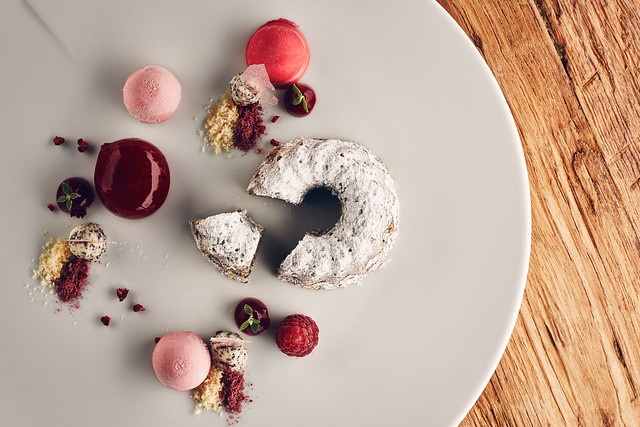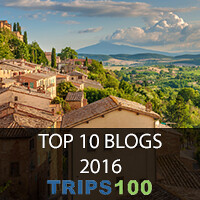Maddie Salters takes on Austrian “couture gastronomy” and finds the experience one for “the record books.”
Austria, like any culture-rich nation, has a consummate tradition of food: timeless recipes, fresh ingredients, and local preferences. That’s given. What I didn’t expect from my four-day trip to Lech, a traditional valley town nestled into the sprightly Alps, was for my farm-fresh experience to cross-over with world-renown couture gastronomy. And here’s the thing about couture: it always fits. (Not sure if I could say the same for my jeans afterwards.)
While it might be impossible to taste your way across a country in so little time, I’ll admit, I tried. As a guest of the Hotel Aurelio, I let the experienced staff there be my culinary guides: a calling they rallied to by designing decadent, multi-course meals, and by letting me engage with the food in surprising and delighting ways. Participating in the process, from fishing my own dinner in a nearby pond, to taking a morning cooking class with their 3-Hauben Chef de Cuisine, deepened my appreciation for each bite.
My first dinner in Lech, in Aurelio’s Licca Lounge, was a meal for the record books. The Licca Lounge, one of three dining options in the plush lower-level of the hotel, creates a cozy atmosphere with wide, embracing sofas, an elegant bar, and deep wooden paneling that echoes the warm ambient light by nightfall. The carte du jour, like the room itself, had been designed specifically to welcome guests to Austria, an introduction to its rich culinary heritage. Farmer’s brown bread swathed in cheese and chive butter, beef tartare with quail egg, smoked local salmon, deconstructed balsamic tomatoes with mozzarella, roasted aubergine in regional spices … mouth watering yet? These were just the starters. (Eating in Lech became synonymous with marathon long-run training.)
I was already fairly stunned and satiated when the real, hearty, melt-in-your-mouth provincial dishes began to roll out: tomato compote soup with delicate haddock cheeks; three-cheese baked speatzle decked out in fried onions; wiener schnitzel in cranberry sauce; veggie-roasted prime beef stew; and a multi-aged Volrarlberg cheese platter. Not to mention Lech’s love affair with potatoes, which were served so many ways, I lost track of everything but the bowl featuring them pan-scalded and scalloped. “Save Room for Dessert” became less of a philosophy and more of a life-goal. (For the record, dessert featured Austrian supper-table musts, like fluffy shredded pancakes “Kaiserschmarrn,” apple strudel, polenta “flummery” pudding, and roast cherries.)
But let me stick to the highlights, before I write myself hungry. After the first meal, I was relatively sure that nothing could compare to my initial enchantment. How does a kitchen staff live up to opening night? The answer was by infusing each new culinary experience with originality and expertise. A good meal isn’t complete without a wine pairing that can hold its own. I was completely impressed by Aurelio’s sommelier, Markus, who not only chose immaculate pairings by course, but who was a staunch believer in Austrian wines. Perfect, since that’s what I was in the region to try. Each bottle came with not just a list of tasting notes, but an itinerary of how sun, soil, and water affect the grapes that had gone into it. My glass was never empty, and whites and reds were switched out flawlessly to match tasting notes on the menu. Even the dessert wine (usually a no for me) needed refilling. After dinner, it was a treat to take a personal tour of the local schnapps on offer, in elegant Swarovski bottles. (On my final night I forwent the loose-leaf sencha tea for a nightcap of spicy 2003 Rochelt, the enticing “Wilde Vogelbeere.”)
I was also thrilled by Aurelio’s dedication to locality. The town’s fishmongers and dairy farmers bring their fare, and the kitchen staff rolls up their sleeves to collect wild mushrooms and herbs to add to their complex dishes. (These are frozen after summer, to be available for dishes throughout winter.) Plates were furnished in candied wildflowers, and decorated in flamboyant petals that I began to recognise from my hikes. As always, Aurelio was happy to tailor the experience, and offers guests the opportunity to pick their own vegetables and medicinal herbs.
The kitchen staff was immaculate. Each meal began with a gift from the chef, not written into the menu, a tiny gastronomic high point to punctuate drinks on the terrace. While I always opted to eat on the sun terrace, with its long, tarrying deck southerly mountain views, and shady spaces, I did take a gander through Restaurant “Aurelio’s”: their fine-dining nook. The kitchen was located just behind it, where award-winning head chef Christian Rescher and Souschef Markus Niederwanger showed me how to toss together a cool lime-wasabi salmon tartare and hand-roll pasta. (For those of us who are not Michelin-starred chefs, Rescher also gives some amazing everyday cooking tips and tricks, useful for making any cuisine. Guests can book cooking classes through Aurelio, and the five-star recipes are sent home with them after.
A high-point was trekking to the Zug pond, led by an Aurelio team, to fish for my dinner. Fishing and hunting are popular in Lech, and Aurelio offers guests a unique service, where catches are filleted and served by their staffers, either in one of Aurelio’s restaurants, or, packed to go with wine and accompaniments, for a sunny summer picnic.
Throughout every meal, the absolute beauty of each plate astounded me as much as the innovation of shapes and flavours. Cucumbers, one of my favourite foods, were served as marshmallows, mousses, and boiled into tapioca. (Don’t even get me started on the many uses of chili foam …)
The moral? Go to Lech hungry.
Check out my other Living Lech posts to find out more.
Hotel Aurelio is located at Tannberg 130, A-6764 Lech am Arlberg, Austria. Learn more at aureliolech.com.























